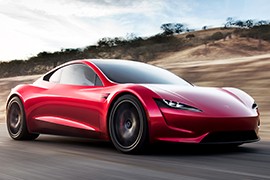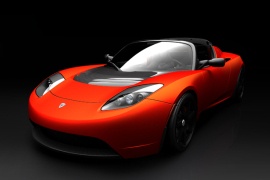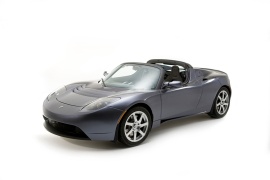TESLA Roadster Models/Series Timeline, Specifications & Photos
First production year: 2008
Engines: Electric
Body style: Convertible (spider/spyder, cabrio/cabriolet, drop/open/soft top)
Revealed at a charity event, the 2020 Tesla Roadster was the modern supercar from the American electric-car manufacturer Tesla.
Tesla built a few models since 2008 when the first Roadster came out from the factory. By 2020, the Model S, Model X, and Model Y started to be seen worldwide. It was not just a local brand anymore, and the electric-car revolution started to pick-up. Other car-manufacturer followed the trend, and soon, Tesla was not the only one to charge its cars at supercharger stations. But they began to lose ground in the performance area.
The 2020 Roadster came to fit in the performance segment and show the world who's the Daddy. It was designed without door-mirrors so the wind-noise won't give it any more troubles. Like the first, 2008, Roadster, it was more of a Targa body than a real roadster since the B-pillars and the safety arch remained in place, and only the glass-panel above the occupants was removable.
Like the 2008 Roadster, the 2020 model-year featured just two seats. Tesla already built enough 5 or 7 seat vehicles with four or five doors. The 2020 Roadster offered two doors and two seats. Unlike its predecessor, the interior was more up-market. The already traditional portrait-mode big screen on the center stack provided the necessary information and car's settings, including the Ludicrous mode.
The powertrain consisted of four motors, one for each wheel. Just a quick reminder, the 2008 Roadster had only one motor. The total power output and the light construction allowed the 2020 Roadster to rocket from 0 to 60 mph (0-97 kph) in less than two seconds!
After a year from storming the market with the little Roadster, Tesla introduced an updated version: another roadster that could run for longer distances and was officially quicker.
Since Tesla was a small company, the chain of command was shorter. So, when Elon Musk asked the R&D department to change something, everything was done faster. There was no need for another ten accounting and five management links to start the development, and in less than a year from the first Roadster, Tesla introduced an updated version.
The designers heard what the market said about the Roadster, which was the complaints and what they had to fix. A new front end was drawn, with different styling for the headlights. Other subtle modifications were performed for the door-mirrors, which were too noisy for the first Roadster, and there was no engine to cover that aerodynamic whistle.
Elon Musk understood that a customer wouldn't pay big money for a car that won't give enough interior comfort, so it re-arranged the cabin. The designers hid the exposed metallic parts from the previous model, and there was more attention to details for the assembly team. The heated sport-seats were fitted as standard and featured inflatable lumbar support, and the leather upholstery was fitted as standard.
The most significant improvement to the car was for the engineering part. Better management for energy consumption and recovery increased the car's range up to 220 miles. As for performances, the little Roadster could rocket to 60 mph (97 kph) in 3.7 seconds. That was very quick for any standards.
This was the firestarter of the electric car revolution. It wasn't the ignition plug since it had none of those: only an electric motor and 4000 cells formed into a battery.
In the dawn of the XIX-th century, the battle between the electric cars and gasoline-powered ones, the latter prevailed. Fast forward a century, the things looked way different, and the American car-company Tesla came with a new idea. That was the 2008 Tesla roadster.
It took the lightest chassis on the market from a Lotus Elise. The little Roadster seemed perfect for the job. The bodywork was adapted. It was still sleek and aerodynamic, with a Targa-style convertible system. In the front bumper, Tesla installed a wide grille needed to cool the battery packs and the engine. Unlike the Elise, it didn't feature side-intakes behind the doors since there was no internal combustion engine to cool it.
The Roadster's interior was very minimalist. A dashboard, a pair of seats, an air-conditioning unit, and a sound system were all the interior equipment. Some metallic parts were still exposed, like in a Lotus Elise. There were even less sound-deadening materials since the electric motor was very silent, and there was no gearbox. The instrument cluster featured two analog dials with a tachometer that showed up to 13.000 rpm. A gauge showed the battery charging status.
The Tesla Roadster faced a few problems when it was launched because the transmission failed. After the problems were fixed and the little open-top vehicle proved its worthiness, the orders started to pile-up, and the waiting line began to be longer. The 0 to 60 mph (0-97 kph) acceleration time was under 4 seconds, and that was faster than any supercar from that era.


